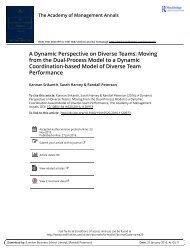The Process of Team Boundary Spanning in Multi-Organizational Contexts - Sarah Harvey, Randall S. Peterson, and N. Anand
Work teams must increasingly operate in complex environments characterized by multiple external actors beyond team and organizational boundaries. Although previous research demonstrates the importance of boundary spanning activities to team effectiveness, it reveals relatively little about the process of boundary spanning in these environments. In this article, we investigated the processes of boundary spanning across multiple external actors in 10 cross-organizational teams. We identified three sequences for reaching out to external actors: (a) moving inside-out from vertical actors inside the host organization to horizontal actors outside of the host organization, (b) moving outside-in from horizontal actors to vertical, and (c) staying-inside with vertical actors from the host organization. Our observations suggest that inside-out and outside-in sequences were more successful than simply pleasing the host organization. We build on our empirical findings to develop a process theory of how team boundary spanning activities across multiple external actors influence team effectiveness. Our research underscores the importance of a team’s interactions with actors in its external environment beyond those in an immediate supervisory role and provides insight into the dynamics of boundary spanning in multi-organizational contexts.
Work teams must increasingly operate in complex environments
characterized by multiple external actors beyond team and organizational
boundaries. Although previous research demonstrates the importance of
boundary spanning activities to team effectiveness, it reveals relatively little
about the process of boundary spanning in these environments. In this article,
we investigated the processes of boundary spanning across multiple external
actors in 10 cross-organizational teams. We identified three sequences for
reaching out to external actors: (a) moving inside-out from vertical actors inside
the host organization to horizontal actors outside of the host organization,
(b) moving outside-in from horizontal actors to vertical, and (c) staying-inside
with vertical actors from the host organization. Our observations suggest
that inside-out and outside-in sequences were more successful than simply
pleasing the host organization. We build on our empirical findings to develop
a process theory of how team boundary spanning activities across multiple
external actors influence team effectiveness. Our research underscores the
importance of a team’s interactions with actors in its external environment beyond those in an immediate supervisory role and provides insight into the
dynamics of boundary spanning in multi-organizational contexts.
You also want an ePaper? Increase the reach of your titles
YUMPU automatically turns print PDFs into web optimized ePapers that Google loves.
528 Small Group Research 45(5)<br />
While early stage l<strong>in</strong>k<strong>in</strong>g activity draws on the resources <strong>of</strong> an external<br />
actor or helps def<strong>in</strong>e a role for the team with<strong>in</strong> the broader environment,<br />
impr<strong>in</strong>t<strong>in</strong>g its <strong>in</strong>itial strategy <strong>in</strong> this way also constra<strong>in</strong>s the team’s future<br />
activities because it determ<strong>in</strong>es external actors’ expectations about a team’s<br />
role <strong>and</strong> goals (Dougherty & Heller, 1994; Galunic & Eisenhardt, 1996).<br />
However, as accomplish<strong>in</strong>g a team’s m<strong>and</strong>ate <strong>of</strong>ten requires reach<strong>in</strong>g<br />
beyond a s<strong>in</strong>gle organization, a team may need to break these expectations<br />
to successfully complete its task. We therefore suggest that dur<strong>in</strong>g midstage<br />
<strong>in</strong>teractions, build<strong>in</strong>g activity helps the team to def<strong>in</strong>e a new relationship<br />
with the external actors with whom it has first established legitimacy<br />
(i.e., the found<strong>in</strong>g actor), <strong>and</strong> <strong>in</strong> do<strong>in</strong>g so, can organize the team to meet its<br />
unique goals.<br />
Proposition 2: Mid-stage build<strong>in</strong>g activity with the external actor to<br />
whom the team first l<strong>in</strong>ked (the found<strong>in</strong>g actor) enables it to develop processes<br />
<strong>and</strong> practices to meet its goals.<br />
<strong>The</strong> sequence <strong>of</strong> activities described so far creates two challenges for<br />
teams. First, by focus<strong>in</strong>g on one external actor, other external actors may<br />
not view themselves as part <strong>of</strong> the team’s environment. Second, while<br />
build<strong>in</strong>g activity serves the <strong>in</strong>strumental purpose <strong>of</strong> enabl<strong>in</strong>g the team to<br />
complete its task effectively, the more the team alters its processes <strong>and</strong><br />
structures to be able to <strong>in</strong>novate, the less it conforms strictly to an exist<strong>in</strong>g<br />
actor’s expectations, <strong>and</strong> therefore the less legitimate it may appear to that<br />
actor (Arndt & Bigelow, 2000). <strong>The</strong> team therefore risks los<strong>in</strong>g its found<strong>in</strong>g<br />
support.<br />
We suggest that late-stage build<strong>in</strong>g activity with an alternate external<br />
actor enables a COT to overcome these challenges. This was a critical po<strong>in</strong>t<br />
<strong>of</strong> departure <strong>of</strong> the <strong>in</strong>side-out <strong>and</strong> outside-<strong>in</strong> sequences we observed.<br />
Build<strong>in</strong>g activity with an alternate external actor enables teams to establish<br />
the legitimacy <strong>of</strong> their newly formed practices with the actor to whom the<br />
team first l<strong>in</strong>ked <strong>and</strong> to build a relationship with other external actors. <strong>The</strong><br />
need to <strong>in</strong>teract with other external actors provides a justification for the<br />
team’s chang<strong>in</strong>g relationship with the orig<strong>in</strong>al external actor that it l<strong>in</strong>ked<br />
to. Conflicts <strong>in</strong> the assumptions, values, <strong>and</strong> goals <strong>of</strong> actors <strong>in</strong> a team’s<br />
environment are likely to exist (Denison, Hart, & Kahn, 1996). In one<br />
sense, reconcil<strong>in</strong>g these conflicts by meet<strong>in</strong>g the needs <strong>of</strong> multiple actors is<br />
the reason the teams exist; these conflicts therefore provide an opportunity<br />
for a team (Benson, 1977). By build<strong>in</strong>g with other external actors, a team<br />
can capitalize on the <strong>in</strong>consistency created by the conflict between actors to<br />
build <strong>and</strong> reta<strong>in</strong> legitimacy. In this way, iterat<strong>in</strong>g between the practices <strong>and</strong><br />
Downloaded from sgr.sagepub.com at London Bus<strong>in</strong>ess School Library on September 24, 2014
















